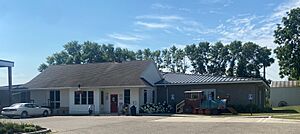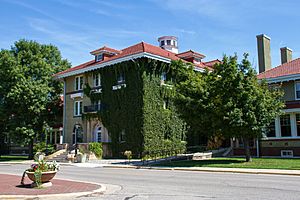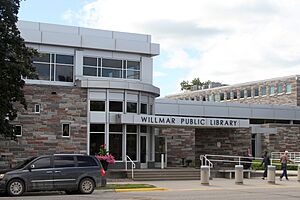Willmar, Minnesota facts for kids
Quick facts for kids
Willmar
|
|
|---|---|
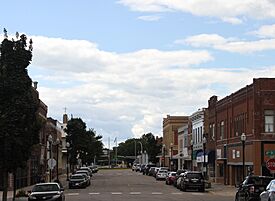
Litchfield Avenue at 4th Street
|
|
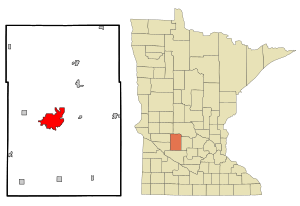
|
|
| Country | United States |
| State | Minnesota |
| County | Kandiyohi |
| Founded | 1871 |
| Incorporated (village) | 1874 |
| Incorporated (city) | 1901 |
| Area | |
| • Total | 15.58 sq mi (40.35 km2) |
| • Land | 14.23 sq mi (36.86 km2) |
| • Water | 1.35 sq mi (3.50 km2) |
| Elevation | 1,129 ft (344 m) |
| Population
(2020)
|
|
| • Total | 21,015 |
| • Estimate
(2022)
|
21,282 |
| • Density | 1,476.81/sq mi (570.21/km2) |
| Time zone | UTC−6 (Central (CST)) |
| • Summer (DST) | UTC−5 (CDT) |
| ZIP Code |
56201
|
| Area code(s) | 320 |
| FIPS code | 27-70420 |
| GNIS feature ID | 2397323 |
Willmar is a city in Minnesota, United States. It is the main city and county seat of Kandiyohi County, Minnesota. In 2020, about 21,015 people lived there.
Contents
History of Willmar
Willmar grew a lot because of farming and its important spot on the Great Northern Railway. This railway helped connect the city to other places. The first people settled here in the 1850s. They liked the rich land and plenty of wood and animals.
After the Dakota War of 1862, the area was empty for a few years. But when the railroad arrived in 1869, new settlers came. Many of them were from Scandinavia, like Sweden and Norway. Even today, many people in Willmar have Scandinavian family roots.
In 1870, a Belgian man named Leon Willmar bought land in the area. He was working for a European company that owned part of the St. Paul and Pacific Railroad. Willmar became the county seat in 1871. It officially became a village in 1874 and a city in 1901.
The Willmar Memorial Auditorium was built in 1938. It was the biggest meeting hall in the area at the time. The city and state and federal governments helped pay for it. This was part of a plan to create jobs during the Great Depression. The building has cool murals by Richard Haines and wood carvings by other artists. It is now a historic place.
From 1977 to 1979, Willmar was known for the Willmar 8. This was a group of female workers who went on strike at a local bank. They were fighting for fair treatment in the workplace. Their story was shared in the news and even made into a documentary.
Bradley Joseph, a musician, grew up in Willmar. His music is inspired by his childhood there. His company, Robbins Island Music, is named after a park in Willmar.
Willmar also hosted the annual Sonshine Festival for many years. This was a Christian music festival that took place from 1982 to 2014.
Geography and Climate
Willmar covers an area of about 15.95 square miles (41.3 square kilometers). Most of this is land, and a smaller part is water.
The 45° latitude line passes just south of Willmar. This means the city is about halfway between the equator and the North Pole.
Climate in Willmar
Willmar has a climate with warm summers and cold winters. Here's a look at the weather:
| Climate data for Willmar, Minnesota, 1991–2020 normals, extremes 1893–present | |||||||||||||
|---|---|---|---|---|---|---|---|---|---|---|---|---|---|
| Month | Jan | Feb | Mar | Apr | May | Jun | Jul | Aug | Sep | Oct | Nov | Dec | Year |
| Record high °F (°C) | 62 (17) |
62 (17) |
79 (26) |
94 (34) |
105 (41) |
103 (39) |
107 (42) |
105 (41) |
105 (41) |
91 (33) |
80 (27) |
64 (18) |
107 (42) |
| Mean maximum °F (°C) | 40.5 (4.7) |
44.3 (6.8) |
61.2 (16.2) |
77.7 (25.4) |
88.5 (31.4) |
91.9 (33.3) |
91.8 (33.2) |
90.2 (32.3) |
87.4 (30.8) |
81.5 (27.5) |
61.0 (16.1) |
44.4 (6.9) |
94.7 (34.8) |
| Mean daily maximum °F (°C) | 20.5 (−6.4) |
25.7 (−3.5) |
38.2 (3.4) |
54.0 (12.2) |
67.6 (19.8) |
77.9 (25.5) |
81.5 (27.5) |
79.4 (26.3) |
72.1 (22.3) |
57.4 (14.1) |
40.1 (4.5) |
26.4 (−3.1) |
53.4 (11.9) |
| Daily mean °F (°C) | 11.7 (−11.3) |
15.8 (−9.0) |
29.1 (−1.6) |
43.8 (6.6) |
57.4 (14.1) |
67.9 (19.9) |
71.7 (22.1) |
69.1 (20.6) |
61.1 (16.2) |
46.9 (8.3) |
31.8 (−0.1) |
18.3 (−7.6) |
43.7 (6.5) |
| Mean daily minimum °F (°C) | 2.9 (−16.2) |
6.0 (−14.4) |
20.1 (−6.6) |
33.6 (0.9) |
47.1 (8.4) |
57.8 (14.3) |
61.9 (16.6) |
58.9 (14.9) |
50.1 (10.1) |
36.5 (2.5) |
23.5 (−4.7) |
10.1 (−12.2) |
34.0 (1.1) |
| Mean minimum °F (°C) | −19.7 (−28.7) |
−15.8 (−26.6) |
−3.8 (−19.9) |
18.9 (−7.3) |
32.8 (0.4) |
45.0 (7.2) |
51.5 (10.8) |
47.2 (8.4) |
34.2 (1.2) |
21.0 (−6.1) |
4.2 (−15.4) |
−13.1 (−25.1) |
−22.3 (−30.2) |
| Record low °F (°C) | −40 (−40) |
−38 (−39) |
−31 (−35) |
−5 (−21) |
19 (−7) |
32 (0) |
39 (4) |
33 (1) |
19 (−7) |
−1 (−18) |
−22 (−30) |
−35 (−37) |
−40 (−40) |
| Average precipitation inches (mm) | 0.68 (17) |
0.67 (17) |
1.39 (35) |
2.63 (67) |
3.33 (85) |
4.79 (122) |
3.99 (101) |
3.89 (99) |
2.64 (67) |
2.40 (61) |
1.42 (36) |
0.84 (21) |
28.67 (728) |
| Average snowfall inches (cm) | 9.2 (23) |
7.8 (20) |
6.9 (18) |
3.8 (9.7) |
0.0 (0.0) |
0.0 (0.0) |
0.0 (0.0) |
0.0 (0.0) |
0.0 (0.0) |
0.5 (1.3) |
7.8 (20) |
10.1 (26) |
46.1 (118) |
| Average precipitation days (≥ 0.01 in) | 6.0 | 4.9 | 6.6 | 8.4 | 11.2 | 12.0 | 9.6 | 8.8 | 8.6 | 9.2 | 5.8 | 6.6 | 97.7 |
| Average snowy days (≥ 0.1 in) | 5.8 | 4.4 | 4.1 | 1.3 | 0.0 | 0.0 | 0.0 | 0.0 | 0.0 | 0.4 | 3.4 | 5.7 | 25.1 |
| Source 1: NOAA | |||||||||||||
| Source 2: NWS/XMACIS2 | |||||||||||||
Population and People
| Historical population | |||
|---|---|---|---|
| Census | Pop. | %± | |
| 1880 | 1,002 | — | |
| 1890 | 1,825 | 82.1% | |
| 1900 | 3,409 | 86.8% | |
| 1910 | 4,135 | 21.3% | |
| 1920 | 5,892 | 42.5% | |
| 1930 | 6,173 | 4.8% | |
| 1940 | 7,623 | 23.5% | |
| 1950 | 9,410 | 23.4% | |
| 1960 | 10,417 | 10.7% | |
| 1970 | 12,869 | 23.5% | |
| 1980 | 15,895 | 23.5% | |
| 1990 | 17,531 | 10.3% | |
| 2000 | 18,351 | 4.7% | |
| 2010 | 19,610 | 6.9% | |
| 2020 | 21,015 | 7.2% | |
| 2022 (est.) | 21,282 | 8.5% | |
| U.S. Decennial Census 2020 Census |
|||
Willmar's Population in 2010
In 2010, there were 19,610 people living in Willmar. There were 7,677 households, which are groups of people living together. The city had about 1,386 people per square mile.
Most people in Willmar (86.9%) were White. About 4.8% were African American, and 0.5% were Native American. People from other backgrounds made up the rest. About 20.9% of the population was Hispanic or Latino.
About 30.5% of households had children under 18 living with them. The average household had 2.43 people. The average age in the city was 33.8 years old.
New Residents in Willmar
Since 1989, many new people have moved to Willmar. They came from places like Latin America and Northeast Africa. Many came for jobs at the Jennie-O poultry plant.
In 2001, Willmar was named an "All America City" by the National Civic League. This was partly because the city did a great job welcoming new immigrants into the community.
In 2005, Willmar's high school cross-country team became famous. Several Somali-American students helped the team win its first state championship in 20 years. The team won again in 2006. This success brought attention from magazines like Sports Illustrated and TV shows like NBC Nightly News. They reported on how Willmar was changing and accepting its new citizens.
Later, a writer named Thomas Friedman wrote about immigration in Willmar for the New York Times in 2019.
Education
Willmar is home to Ridgewater College. This is a college that offers two-year programs and technical training. It is located on a former military base. Ridgewater College has over 5,500 students. It also works with other universities to offer some four-year programs.
The city also has Willmar High School and Willmar Community Christian School.
Transportation
Several main roads pass through Willmar. These include U.S. Highways 12 and 71. Also, Minnesota State Highways 23 and 40 are important routes in the city.
Willmar grew a lot because it was a meeting point for many railway lines. The Great Northern Railway had lines going in many directions from Willmar. You could travel east to Minneapolis, northwest to Fargo, northeast to St. Cloud, and southwest to Sioux Falls. The last passenger train left Willmar station in 1979.
Sports
Willmar has local sports teams that play in different leagues.
| Team | League | Venue |
|---|---|---|
| Willmar Stingers | Northwoods League, Baseball | Bill Taunton Stadium |
| Willmar WarHawks | NA3HL, Ice Hockey | Willmar Civic Center |
Media
Willmar has different types of media to keep people informed and entertained.
Newspapers
- West Central Tribune
- La Gran America (This newspaper is in three languages)
Magazines
- Seasons of Minnesota
Television stations
- UHF-TV Inc.
WRAC TV - Regional Access Channel
Broadcast Television
| Channel | Callsign | Affiliation | Branding | Subchannels | Owner | |
|---|---|---|---|---|---|---|
| (Virtual) | Channel | Programming | ||||
| 4.1 | K33OT-D (WCCO Translator) |
CBS | WCCO 4 | 4.2 | Start TV | UHF Television, Inc. |
| 9.9 | K30FZ-D (KMSP Translator) |
FOX | FOX 9 | 9.4 9.5 9.6 |
Buzzr Light TV Decades |
UHF Television, Inc. |
| 9.2 | K36OL-D (WFTC Translator) |
Ind. | FOX 9 Plus | 9.3 9.1 |
Movies! FOX |
UHF Television, Inc. |
| 10.1 | K22ND-D (KWCM Translator) |
PBS | Pioneer Public TV | 10.2 10.3 10.4 10.5 |
Create Minnesota Channel World PBS Kids |
UHF Television, Inc. |
| 11.1 | K17FA-D (KARE Translator) |
NBC | KARE 11 | 11.2 11.3 11.4 |
Court TV True Crime Network Quest |
UHF Television, Inc. |
| 23.1 | K14LF-D (WUCW Translator) |
CW | CW 23 | 23.2 23.3 23.4 |
Comet Charge! TBD |
UHF Television, Inc. |
| 28.1 | K28IF-D | TBN | 28.2 28.3 |
Hillsong Channel JUCE TV |
UHF Television, Inc. | |
| 34.1 | K34HO-D | Reelz | 5.4 5.6 34.2 34.3 |
Antenna TV This TV Kool-TV Retro TV |
UHF Television, Inc. | |
| 35.1 | K35NR-D | Heartland | 35.2 35.3 35.4 |
Retro TV Rev'n Family |
UHF Television, Inc. | |
| 41.1 | K26NU-D (KPXM Translator) |
ION | ION | 41.2 41.3 41.4 41.5 41.6 |
Qubo Ion Plus ION Shop QVC HSN |
UHF Television, Inc. |
| 42.1 | K19IH-D (KSAX Translator) |
ABC | 5 Eyewitness News | 42.2 42.3 |
45TV MeTV |
UHF Television, Inc. |
Pay Television Services
Radio Stations
| AM radio stations | ||||
|---|---|---|---|---|
| Frequency | Call sign | Name | Format | Owner |
| 1340 | KWLM | News/Talk | Lakeland Broadcasting Company | |
| 1590 | KDJS | Classic country | Iowa City Broadcasting Company | |
| FM radio stations | ||||
|---|---|---|---|---|
| Frequency | Call sign | Name | Format | Owner |
| 90.9 | KKLW | K-Love | Christian | Educational Media Foundation |
| 91.9 | KBHZ | Praise Live | Christian | North Central University |
| 92.7 | K224DB (KTIS-FM Translator) |
Life 98.5 | Contemporary Christian | University of Northwestern - St. Paul |
| 94.1 | KKLN | 94.1 The Loon | Classic rock | Headwaters Media, Inc. |
| 95.3 | KDJS | K-95.3 | Country | Iowa City Broadcasting, Inc. |
| 96.3 | K242CF (KWLM-AM Translator) |
News/Talk | Lakeland Broadcasting Company | |
| 100.1 | KOLV | Big Country 100.1 | Country | Bold Radio, Inc. |
| 102.5 | KQIC | Q102 | Hot AC | Lakeland Broadcasting Company |
| 103.3 | K277CC (KTIS-AM Translator) |
Faith 900 | Christian talk and teaching | University of Northwestern - St. Paul |
| 105.7 | K289CO (KDJS-AM Translator) |
Classic country | Iowa City Broadcasting Company | |
| 106.5 | KLFN | 106.5 The Train | Classic Hits | Lakeland Broadcasting Company |
Notable People from Willmar
Many interesting people have come from Willmar, including:
- Thomas K. Berg – a politician and lawyer
- Wallace Gustafson – a lawyer and politician
- Olof Hanson – an architect
- Bonnie Henrickson – a college basketball coach
- Roy C. Jensen – a farmer and politician
- Dean Johnson – a politician
- Robert George Johnson – a politician
- Carl O. Jorgenson – a politician
- Bradley Joseph – a composer and recording artist
- Pinky Nelson – an astronaut
- Alec G. Olson – a politician
- Earl B. Olson – the person who started the Jennie-O Turkey company
- Kenneth L. Olson – a soldier in the United States Army
- Jim Pederson (American football) - a professional football player
- Henrik Shipstead – a politician
- Curt Swan – an artist who drew Superman comics
- Rick Swenson – a dog musher and Iditarod participant
- Alan Welle – a politician and businessman
- Henry G. Young – a lawyer and politician
Sister Cities
Willmar has special connections with cities in other countries. These are called sister cities:
See also
 In Spanish: Willmar (Minnesota) para niños
In Spanish: Willmar (Minnesota) para niños


